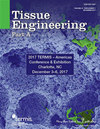投稿信息
稿件收录要求
Tissue Engineering is the preeminent, biomedical journal advancing the field with cutting-edge research and applications on all aspects of tissue growth and regeneration. This multidisciplinary journal brings together the principles of engineering and life sciences in tissue development and regenerative medicine. Tissue Engineering is divided into three parts, providing a central forum for groundbreaking scientific research and developments of clinical applications from leading experts in the field that will enable contributions to the ultimate care of patients.
Tissue Engineering (Part A) is the authoritative peer-reviewed journal focusing on the convergence of the life sciences, engineering, and medicine for the generation of viable biological tissues to better fundamentally understand and treat human disease. Part A publishes 24 issues per year.
Tissue Engineering Reviews (Part B) meets the urgent need for high-quality review articles by presenting critical discussions, analyses, and concise summaries of research within the field to assess history, current standing, and future directions within critical areas. Part B publishes bi-monthly.
Tissue Engineering Methods (Part C) presents high-quality procedures and protocols to promote consistency within the field, distribute beneficial tools and assays, and help the field to grow and mature for current and future clinical translation. Part C publishes monthly.
Tissue Engineering, Parts A, B, & C are under the editorial leadership of Co-Editors-in-Chief Antonios G. Mikos, PhD, Rice University; Peter C. Johnson, MD, Scintellix, LLC; Reviews Co-Editor-in-Chief John P. Fisher, PhD, Fischell Department of Bioengineering, University of Maryland; Methods Co-Editor-in-Chief John A. Jansen, DDS, PhD, Department of Biomaterials, Radboud University Nijmegen Medical Center; and other leading investigators. View the entire editorial board.
Various members of the editorial board are interviewed regularly and featured in the news for their breakthroughs in tissue and organ developments.
Audience: Biomedical and biomaterials engineers, materials and biomaterials scientists, stem cell researchers, biochemists, biophysicists, wound care specialists, orthopedic surgeons, and government regulators, among others.




